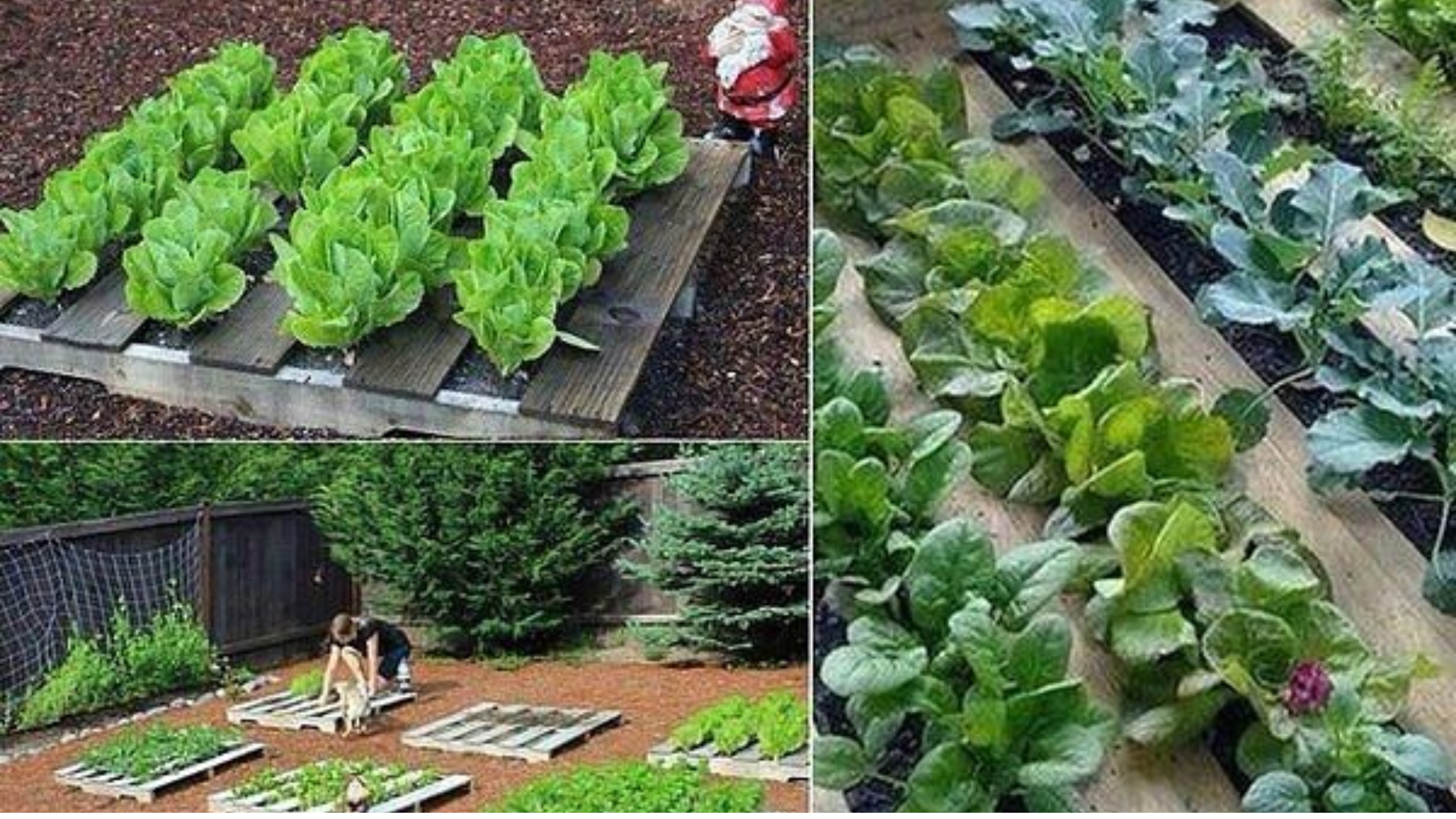Your first step is choosing the proper pallets. Not all pallets are created equal, so it’s essential to select ones in good condition. Look for pallets that are clean, sturdy, and free from damage. Avoid pallets that appear cracked, broken, or have rough, splintered wood, as these can harbor mold or pests.
It’s also wise to choose pallets marked with “HT” (heat-treated) instead of those with chemical treatments like “k” or “p,” which can contain harmful substances not safe for growing edible plants. Opt for untreated pallets or those certified for food contact to ensure safety.
By starting with high-quality pallets, you set a sturdy foundation for your garden, helping your plants thrive and preventing potential health hazards.
Clean and Prepare Your Pallets for Planting
Before planting, cleaning your pallets thoroughly is crucial. Use a stiff brush and warm soapy water to scrub away dirt, dust, and residues. Rinse well to remove any leftover debris.
If you notice any mold or mildew, treat it with a solution of one part white vinegar to three parts water. Let the pallets dry completely in the sun—sunlight acts as a natural disinfectant and helps eliminate germs and pests.
Proper cleaning not only ensures a healthy environment for your plants but also extends the life of your pallets. Once clean and dry, you’re ready to prepare your planting space.
Select the Perfect Vegetables and Fruits
Now comes the fun part—choosing what to grow! For small pallet gardens, consider vegetables and fruits that grow well in limited space and don’t require deep soil. Some great options include:
- Beans: Easy to grow and tend to produce quickly.
- Lettuce and Spinach: Leafy greens that grow fast and can be harvested multiple times.
- Celery: Adds crunch and flavor to your meals.
- Strawberries: Delightful berries that love container-like spaces.
Think about your favorite fresh produce and your local climate. This ensures a higher chance of success and a more satisfying harvest.
How to Prepare the Soil

The foundation of healthy plants is good soil. Fill each section of your pallet with a layer of rich soil or compost. This provides the nutrients plants need to grow strong and vibrant.
Use quality potting mix or garden soil mixed with compost for enhanced fertility. Fill the gaps between the pallets, ensuring the soil is evenly distributed. You want enough depth for roots to develop, typically around 4-6 inches for most vegetables.
Adding a layer of mulch on top can help retain moisture and suppress weeds, making your gardening journey easier and more productive.
Planting Your Seeds: Following Instructions
Follow the seed packet instructions carefully. Different plants have different needs—some require direct sowing, while others may benefit from pre-soaking or starting indoors.
Distribute seeds evenly across the soil, and gently cover them with a thin layer of soil. Use a watering can or spray bottle to moisten the area, being careful not to wash away the seeds.
Label your sections if you’re planting multiple varieties, especially for small setups. Patience and proper planting techniques are key to successful germination.
Watering: Keeping Plants Happy
Consistent watering is vital. Keep the soil moist but not waterlogged. Check your plants daily—particularly during hot or windy days—and water early in the morning or late in the afternoon.
Overwatering can lead to root rot, so ensure good drainage, especially if your pallets don’t have drainage holes. A good rule of thumb is to feel the soil; if it’s dry a couple of inches below the surface, it’s time to water.
Sunlight: Essential for Growth
Most vegetables and fruits crave sunlight. Place your pallets in a sunny spot where they can bask in natural light for at least 4-6 hours daily.
If outdoor space is limited, consider a balcony, patio, or windowsill with good sun exposure. Sunlight encourages healthy growth, sweeter fruits, and faster germination.
Gardening is Fun—Enjoy Every Step!
Gardening isn’t just about growing food—it’s also about reconnecting with nature, learning patience, and enjoying the process. Celebrate each small victory, whether it’s the first sprout or a ripe strawberry.
Take photos of your progress, share with friends and family, and simply enjoy the satisfaction of nurturing life from seed to harvest. Gardening can boost your mood, provide fresh produce, and give you a sense of accomplishment.
Final Tips & Encouragement
- Stay consistent with watering and care.
- Keep an eye out for pests and weeds and address issues promptly.
- Experiment with different plants to discover what grows best in your environment.
Starting your pallet garden is a simple, cost-effective way to grow your own food and create a beautiful, productive space. Soon, you’ll enjoy the taste of homegrown produce—and the joy of nurturing your very own green oasis.
Happy gardening!
Allez plus loin——analyse approfondie avec Deep Research
Obtenez une réponse plus intelligente de GPT-4.1

Add Post ‹ green garden — WordPress
Résumer


cheap amoxil online – cheap amoxicillin tablets buy generic amoxicillin for sale
diflucan 200mg sale – this buy diflucan pills
cenforce 100mg ca – cenforce rs purchase cenforce sale
best place to get cialis without pesricption – mantra 10 tadalafil tablets cialis by mail
how long does cialis take to work 10mg – https://strongtadafl.com/ ambrisentan and tadalafil combination brands
zantac 300mg oral – https://aranitidine.com/ ranitidine 300mg oral
how to order viagra online – cheap herbal viagra pills 50 off viagra
This is the amicable of content I have reading. https://buyfastonl.com/amoxicillin.html
More posts like this would persuade the online space more useful. https://gnolvade.com/
Facts blog you be undergoing here.. It’s obdurate to on great status writing like yours these days. I justifiably recognize individuals like you! Withstand care!! https://ursxdol.com/get-cialis-professional/
Thanks recompense sharing. It’s first quality. https://prohnrg.com/product/get-allopurinol-pills/
Greetings! Utter useful suggestion within this article! It’s the little changes which liking espy the largest changes. Thanks a lot in the direction of sharing! https://aranitidine.com/fr/modalert-en-france/
More posts like this would prosper the blogosphere more useful. https://ondactone.com/product/domperidone/
More posts like this would make the online space more useful.
buy meloxicam no prescription
With thanks. Loads of conception! http://www.iheartmyteacher.org/proxy.php?link=https://wakelet.com/wake/Ygm_w25-9BwVAfPHOoN7B
Greetings! Extremely serviceable suggestion within this article! It’s the scarcely changes which liking espy the largest changes. Thanks a quantity quest of sharing! http://www.fujiapuerbbs.com/home.php?mod=space&uid=3616668
dapagliflozin over the counter – https://janozin.com/ dapagliflozin 10 mg pill
xenical price – https://asacostat.com/# buy orlistat 120mg generic
This is a topic which is forthcoming to my heart… Many thanks! Faithfully where can I upon the contact details an eye to questions? http://mi.minfish.com/home.php?mod=space&uid=1421062
You can shelter yourself and your ancestors nearby being alert when buying medicine online. Some pharmaceutics websites manipulate legally and provide convenience, privacy, cost savings and safeguards to purchasing medicines. buy in TerbinaPharmacy https://terbinafines.com/product/keppra.html keppra
Thanks for putting this up. It’s evidently done. TerbinaPharmacy
This is the kind of literature I positively appreciate.